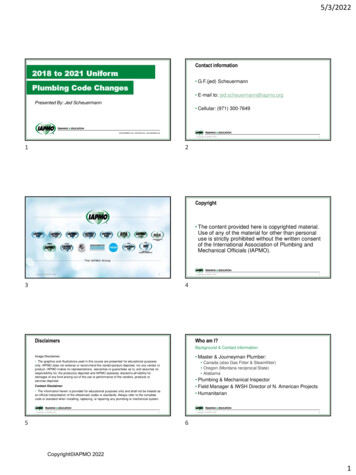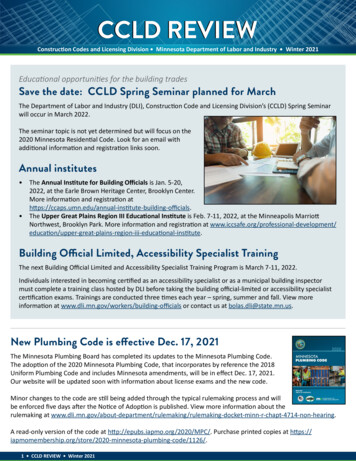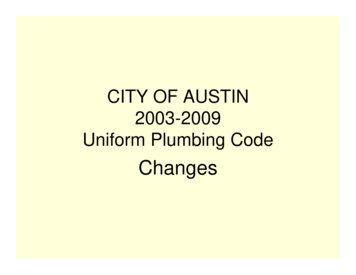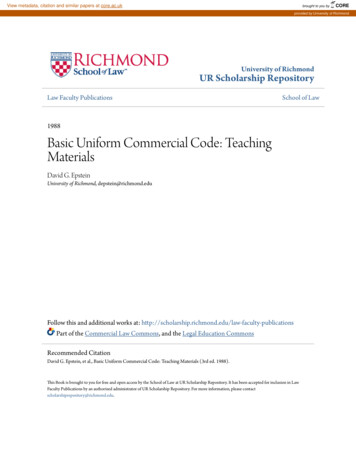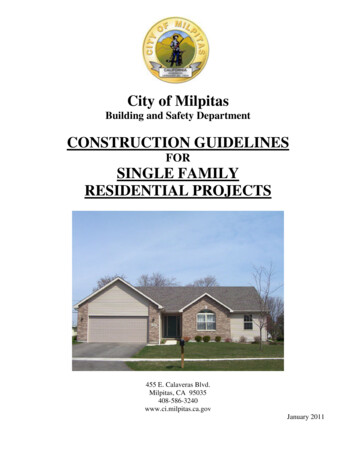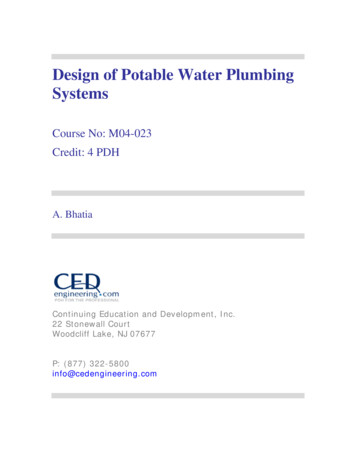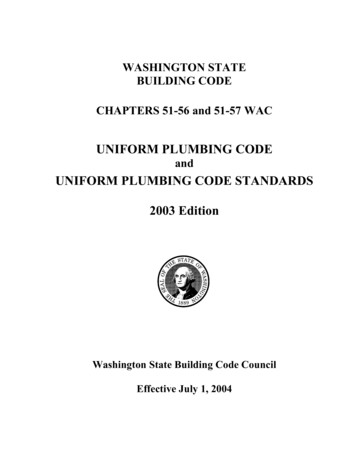
Transcription
WASHINGTON STATEBUILDING CODECHAPTERS 51-56 and 51-57 WACUNIFORM PLUMBING CODEandUNIFORM PLUMBING CODE STANDARDS2003 EditionWashington State Building Code CouncilEffective July 1, 2004
Copies of the State Building Codes may be obtained from:Washington Association of Building OfficialsPost Office Box 7310Olympia, Washington 98507-7310(360) 586-6725www.wabo/order bo.htmlComplete copies of the 2003 Uniform Plumbing Code as published by theInternational Association of Plumbing and Mechanical Officialsmay be obtained from:International Association of Plumbing and Mechanical Officials5001 E. Philadelphia St.Ontario, CA 91761(800) 85-IAPMO htmlSecond Edition TitledUniform Plumbing CodeChapters 51-56/51-57 WACEffective July 1, 2004Printed March 2004Second Edition based onWSR 04-01-110
PrefaceAuthority: The Uniform Plumbing Code (Chapters 51-56 and 51-77 WAC) is adopted by the Washington State Building CodeCouncil pursuant to Chapters 19.27 and 70.92 RCW. This code was first adopted by reference by the Washington StateLegislature in 1974. In 1985, the Legislature delegated the responsibility of adoption and amendment of these codes to the StateBuilding Code Council.Supersession of Previous Codes: Chapters 51-56 and 51-57 WAC supersede Chapters 51-46 and 51-47 WAC.Code Precedence: The State Building Code Act, Chapter 19.27 RCW, establishes the following order of precedence among thedocuments adopted as parts of the State Building Code:International Building Code, Standards and amendments – WAC 51-50;International Residential Code, Standards and amendments – WAC 51-51;International Mechanical Code, Standards and amendments – WAC 51-52;International Fire Code, Standards and amendments – WAC 51-54;Uniform Plumbing Code, Standards and amendments – WAC 51-56, 51-57.Where there is a conflict between codes, an earlier named code takes precedence over a later named code. In the case of conflictbetween the duct insulation requirements of the International Mechanical Code and the duct insulation requirements of theEnergy Code, the Energy Code, or where applicable, a local jurisdiction's energy code, shall govern.Where, in any specific case, different sections of this Code specify different materials, methods of construction or otherrequirements, the most restrictive shall govern. Where there is conflict between a general requirement and a specificrequirement, the specific requirement shall be applicable.Organization and Numbering: These rules are written to allow compatible use with the Uniform Plumbing Code. All sectionswhich are amended, deleted, or added are referenced.Enforcement: The State Building Code Act requires that each local jurisdiction enforce the State Building Code within itsjurisdiction. Any jurisdiction can contract with another jurisdiction or an inspection agency to provide the mandatedenforcement activities.Amendments to the State Building Code:The State Building Code Council has adopted review procedures and approval criteria for local amendments. These proceduresand criteria are found in Chapter 51-04 WAC. The Council has exempted from its review any amendments to the administrativeprovisions of the various codes.Forms for proposing statewide amendments to the State Building Code are available from the State Building Code Council staff.A. Amendments of Statewide Application: On a yearly basis the State Building Code Council will consider proposals toamend the State Building Code. The Council is not scheduled to enter formal rulemaking until 2006 as part of itsconsideration of adoption of the 2006 series of codes.Proposals to amend the State Building Code shall be made on forms provided by the Building Code Council.Code Change Proposal Submittal Deadline: March 1st of each year.i
B. Local Amendments: Any jurisdiction may amend the State Building Code provided the amendments do not reduce theminimum performance standards of the codes. There are two areas where local amendments are limited or prohibited:Prohibited Amendments: Residential provisions of the State Energy Code (WAC 51-11), the Ventilation and IndoorAir Quality Code (WAC 51-13); any provision of the International Building Code or International Residential Codeaffecting accessibility; and standards specifically adopted in Chapters 19.27 and 19.27A WAC cannot be amended byany local jurisdiction.Residential Amendments: Amendments by local jurisdictions which affect the construction of single family andmulti-family residential buildings must be reviewed and approved by the State Building Code Council before suchamendments can be enforced. The State Building Code Act provides the following definition:Multi-family residential building: means common wall residential buildings that consist of four or fewerunits, that do not exceed two stories in height, that are less than 5,000 square feet in area, and that have aone-hour fire-resistive occupancy separation between units.Application forms for Council review of local amendments are available from the State Building Code Council Staff.Washington State Building Code CouncilPost Office Box 42525Olympia, Washington 98504-2525www.sbcc.wa.gov(360) 725-2966 Fax (360) 586-9383e-mail: sbcc@cted.wa.govPrinting Format: This version of the rules is published as a series of insert or replacement pages. Each page providesinstructions for installing them in the model code book. Amendments to the model code which are new or revised from theprevious edition of this code are indicated by a line in the margin next to the revised portions.Effective Date: These rules were adopted by the State Building Code Council on November 21, 2003. The rules are effectivethroughout the state on July 1, 2004. (This version of the code is based on WAC 51-56 and 51-57 as published in WSR 04-01110. It is subject to review by the State Legislature during the 2004 session.)Building Permit Fees: The activities of the State Building Code Council are supported by permit fees collected by each cityand county. Section 19.27.085 of the State Building Code Act requires that a fee of 4.50 be imposed on each building permitissued by each city and county. In addition, a fee of 2.00 per unit shall be imposed for each dwelling unit after the first unit, oneach building containing more than one residential unit. For the purpose of this fee, WAC 365-110-035 defines building permitsas any permit to construct, enlarge, alter, repair, move, improve, remove, convert or demolish any building or structure regulatedby the Building Code. Exempt from the fee are plumbing, electrical, mechanical permits, permits issued to install amobile/manufactured home, commercial coach or factory built structure, or permits issued pursuant to the International FireCode.Each city and county shall remit moneys collected to the state treasury quarterly. No remittance is required until a minimum of 50.00 has accumulated.These permit fees are the amounts current in January 2004. Such fees may be changed by the State Legislature.Opinions: Only at the request of local enforcement officials, the State Building Code Council may issueinterpretations/opinions of those provisions of the State Building Code created by the Council, or provisions of the model codesamended by the Council. Final interpretation authority for any specific permit resides with the local enforcement official.ii
Table of ContentsSectionPageWAC 51-56-001Authority . AWAC 51-56-002Purpose . AWAC 51-56-003Uniform Plumbing Code . AWAC 51-56-007Exceptions . AWAC 51-56-008Implementation . AWAC 51-56-0100Chapter 1 AdministrationWAC 51-56-0101Section 101 – Title, Scope and General . 1WAC 51-56-0102Section 102 – Organization and Enforcement . 3WAC 51-56-0103Section 103 – Permits and Inspections . 3WAC 51-56-0200Chapter 2 DefinitionsWAC 51-56-0205Section 205 – C . 12WAC 51-56-0218Section 218 – P . 16WAC 51-56-0300Chapter 3 General RegulationsWAC 51-56-0301Section 301 – Materials – Standards and Alternates . 19WAC 51-56-0311Section 311 – Prohibited Fittings and Practices . 21WAC 51-56-0313Section 313 – Protection of Piping, Materials and Structures . 21WAC 51-56-0400Chapter 4 Plumbing Fixtures and Fixture FittingsWAC 51-56-0402Section 402 – Water-Conserving Fixtures and Fittings . 27WAC 51-56-0412Section 412 – Floor Drains and Shower Stalls . 29WAC 51-56-0413Section 413 – Minimum Number of Required Fixtures . 31WAC 51-56-0500Chapter 5 Water HeatersWAC 51-56-0501Section 501 – General . 37Table 5-1 . 37WAC 51-56-0502Section 502 – Definitions . 37WAC 51-56-0504Section 504 – Inspections . 38WAC 51-56-0505Section 505 – Prohibited Locations . 38WAC 51-56-0506Section 506 – Oil-Burning and Other Water Heaters . 38WAC 51-56-0507Section 507 – Air for Combustion and Ventilation . 38WAC 51-56-0509Section 509 – Equipment on Roofs . 44WAC 51-56-0512Section 512 – Direct Vent Equipment . 63iii
WAC 51-56-0600Chapter 6 Water Supply and DistributionWAC 51-56-0603Section 603 – Cross-connection Control . 92WAC 51-56-0604Section 604 – Materials . 96WAC 51-56-0608Section 608 – Water Pressure, Pressure Regulators,Pressure Relief Valves, and Vacuum Relief Valves . 99WAC 51-56-0610Section 610 – Size of Potable Water Piping . 103WAC 51-56-0700Chapter 7 Sanitary DrainageWAC 51-56-0701Section 701 – Materials . 107WAC 51-56-0704Section 704 – Fixture Connections (Drainage) . 109WAC 51-56-0710Section 710 – Drainage of Fixtures Located Below theUpstream Manhole or Below the Main Sewer Level . 113WAC 51-56-0713Part II – Building Sewers . 115WAC 51-56-0800Chapter 8 Indirect WastesWAC 51-56-0810Section 810 – Steam and Hot Water DrainageCondensers and Sumps . 121WAC 51-56-0900Chapter 9 VentsWAC 51-56-0903Section 903 – Materials . 123WAC 51-56-1100Chapter 11 Storm DrainageWAC 51-56-1101Section 1101 – General . 133WAC 51-56-1108Section 1108 – Controlled Flow Roof Drainage . 141WAC 51-56-1300Chapter 13 Medical Gas SystemsWAC 51-56-1309Section 1309 – Application . 188WAC 51-56-1331Section 1331 – System Verification . 204WAC 51-56-1400Chapter 14 Referenced StandardsWAC 51-56-1401Section 1401 – Referenced Standards . 211WAC 51-57-001Authority . BWAC 51-57-002Purpose . BWAC 51-57-003Uniform Plumbing Code Standards . BWAC 51-57-007Exceptions . BWAC 51-57-008Implementation . Biv
WAC 51-57-790000IAPMO IS 7-90, Polyethylene Cold Water Building Supplyand Yard PipingSection 604 Materials . 326WAC 51-57-895000IAPMO IS 8-95, PVC Cold Water Building Supplyand Yard PipingSection 604 Materials . 333WAC 51-57-202000IAPMO IS 20-2000, CPVC Solvent CementedHot and Cold Water Distribution SystemsSection 301.1 Minimum Standards . 369v
Washington State AmendmentsCHAPTER 51-56 WACSTATE BUILDING CODE ADOPTION AND AMENDMENTOF THE 2003 EDITION OF THE UNIFORM PLUMBING CODEWAC 51-56-001 AUTHORITY.WAC 51-56-007 EXCEPTIONS.These rules are adopted under the authority of Chapter19.27 RCW.The exceptions and amendments to the model codescontained in the provisions of Chapter 19.27 RCW shallapply in cases of conflict with any of the provisions ofthese rules.WAC 51-56-002 PURPOSE.The purpose of these rules is to implement the provisions ofChapter 19.27 RCW, which provides that the StateBuilding Code Council shall maintain the State BuildingCode in a status which is consistent with the purpose as setforth in RCW 19.27.020. In maintaining the codes, thecouncil shall regularly review updated versions of the codesadopted under the act, and other pertinent information, andshall amend the codes as deemed appropriate by theCouncil.Codes referenced which are not adopted through RCW19.27.031 or Chapter 19.27A RCW shall not apply unlessspecifically adopted by the authority having jurisdiction.WAC 51-56-008 IMPLEMENTATION.The Uniform Plumbing Code adopted by Chapter 51-56WAC shall become effective in all counties and cities ofthis state on July 1, 2004, unless local governmentresidential amendments have been approved by the StateBuilding Code Council.WAC 51-56-003 UNIFORM PLUMBING CODE.ÖThe 2003 edition of the Uniform Plumbing Code, publishedby the International Association of Plumbing andMechanical Officials, is hereby adopted by reference withthe following additions, deletions and exceptions:PROVIDED that Chapters 12, and 15 of this code are notadopted. PROVIDED FURTHER, that those requirementsof the Uniform Plumbing Code relating to venting andcombustion air of fuel fired appliances as found in Chapter5 and those portions of the Code addressing buildingsewers are not adopted.AEffective 7/01/04
2003 Uniform Plumbing CodeEffective 7/01/04
Washington State AmendmentsEffective 7/01/04
2003 Uniform Plumbing Code101.4.1.4 Conflicts Between Codes. Deleteparagraph.(Insert Facing Page 1)Effective 7/01/04
Washington State AmendmentsEffective 7/01/04
2003 Uniform Plumbing Code103.1.3 Certification. State rules and regulationsconcerning certification shall apply.102.4 Appeals. All persons shall have the right toappeal a decision of the Authority Having Jurisdiction. Thejurisdiction shall have a board of appeals to hear and ruleon Plumbing Code appeals. Members of the board shall beappointed by the jurisdiction. Decisions by the board shallbe reported to the jurisdiction and administered by theAuthority Having Jurisdiction.(Insert Facing Page 3)Effective 7/01/04
Washington State AmendmentsCertified Backflow Assembly Tester – A personcertified by the Washington State Department of Healthunder Chapter 246-292 WAC to inspect (for correctinstallation and approval status) and test (for properoperation) approved backflow assemblies.(Insert Facing Page 12)Effective 7/01/04
2003 Uniform Plumbing CodeEffective 7/01/04
Washington State AmendmentsPlumbing System – Includes all potable water buildingsupply and distribution pipes, all plumbing fixtures andtraps, all drainage and vent pipe(s), and all building drainsincluding their respective joints and connection, devices,receptors, and appurtenances within the property lines ofthe premises and shall include potable water piping, potablewater treating or using equipment, medical gas and medicalvacuum systems, and water heaters: Provided, that nocertification shall be required for the installation of aplumbing system within the property lines and outside abuilding.(Insert Facing Page 16)Effective 7/01/04
2003 Uniform Plumbing CodeEffective 7/01/04
Washington State AmendmentsEffective 7/01/04
2003 Uniform Plumbing Code301.1.3 Standards. Standards listed or referred toin this chapter or other chapters cover materials whichwill conform to the requirements of this Code, whenused in accordance with the limitations imposed in thisor other chapters thereof and their listing. Where astandard covers materials of various grades, weights,quality, or configurations, there may be only a portionof the listed standard which is applicable. Design andmaterials for special conditions or materials notprovided for herein are allowed to be used by specialpermission of the Authority Having Jurisdiction afterthe Authority Having Jurisdiction has been satisfied asto their adequacy in accordance with Section 301.2.(Insert Facing Page 19)Effective 7/01/04
Washington State AmendmentsEffective 7/01/04
2003 Uniform Plumbing Code311.4 Except as hereinafter provided in Sections 908.0,909.0, 910.0, and Appendix L, Section L 6.0, no vent pipeshall be used as a soil or waste pipe, nor shall any soil orwaste pipe be used as a vent.313.6 No water, soil, or waste pipe shall be installed orpermitted outside of a building or in an exterior wall unless,where necessary, adequate provision is made to protectsuch pipe from freezing. All hot and cold water pipesinstalledoutside the conditioned space shall be insulated to aminimum R-3.(Insert Facing Page 21)Effective 7/01/04
Washington State Amendments313.7 All pipes penetrating floor/ceiling assemblies andfire-resistance rated walls or partitions shall be protected inaccordance with the requirements of the building code.314.5.1 In Seismic Design Categories C, D, E and Fhubless cast iron piping in sizes 5 inches and largersuspended in exposed locations over public or high trafficareas, pipe over 4 feet in length shall be provided withsupport on both sides of the coupling.(Insert Facing Page 22)Effective 7/01/04
2003 Uniform Plumbing CodeEffective 7/01/04
Washington State AmendmentsEffective 7/01/04
2003 Uniform Plumbing Code402.0 Water-Conserving Fixtures and Fittings.402.1 The purpose of this Section shall be to implementwater conservation performance standards in accordancewith RCW 19.27.170.402.2 Application. This Section shall apply to all newconstruction and all remodeling involving replacement ofplumbing fixtures and fittings in all residential, hotel,motel, school, industrial, commercial use, or otheroccupancies determined by the council to use significantquantities of water. Plumbing fixtures, fittings andappurtenances shall conform to the standards specified inthis Section and shall be provided with an adequate supplyof potable water to flush and keep the fixtures in a cleanand sanitary condition without danger of backflow or crossconnection.402.3 Water Efficiency Standards.402.3.1 Standards for Vitreous China PlumbingFixtures.402.3.1.1 The following standards shall be adopted asplumbing materials, performance standards, and labelingstandards for water closets and urinals. Water closets andurinals shall meet either the ANSI/ASME standards or theCSA standard.ANSI/ASME A112.19.2M-1998ANSI/ASME A112.19.6-1995CSA B45Vitreous China PlumbingFixturesHydraulic Requirementsfor Water Closets andUrinalsCSA Standards onPlumbing Fixtures402.3.1.2 The maximum water use allowed in gallons perflush (gpf) or liters per flush (lpf) for any of the followingwater closets shall be the following:Tank-type toilets1.6 gpf/6.0 lpfFlushometer-valve toilets1.6 gpf/6.0 lpfFlushometer-tank toilets1.6 gpf/6.0 lpfElectromechanical hydraulic toilets1.6 gpf/6.0 lpfExceptions: 1. Water closets located in day care centers,intended for use by young children may have a maximumwater use of 3.5 gallons per flush or 13.25 liters per flush.2. Water closets with bed pan washers may have a maximumwater use of 3.5 gallons per flush or 13.25 liters per flush.3. Blow out bowls, as defined in ANSI/ASME A112.19.2M,Section 5.1.2.3 may have a maximum water use of 3.5gallons per flush or 13.25 liters per flush.402.3.1.3 The maximum water use allowed for any urinalshall be 1.0 gallons per flush or 3.78 liters per flush.402.3.1.4 No urinal or water closet that operates on acontinuous flow or continuous flush basis shall bepermitted.402.3.1.5 This section does not apply to fixtures installedbefore the effective date of this Section, that are removedand relocated to another room or area of the same buildingafter the effective date of this Section.402.3.2 Standards for Plumbing Fixture Fittings.402.3.2.1 The following standards are adopted asplumbing material, performance requirements, and labelingstandards for plumbing fixture fittings. Faucets, aerators,and shower heads shall meet either the ANSI/ASMEstandard or the CSA standard.ANSI/ASME A112.18.1M-1996CSA B125Plumbing Fixture FittingsPlumbing Fittings402.3.2.2 The maximum water use allowed for anyshower head is 2.5 gallons per minute or 9.5 liters perminute.Exception: Emergency use showers shall be exempt fromthe maximum water usage rates.402.3.2.3 The maximum water use allowed in gallons perminute (gpm) or liters per minute (lpm) for any of thefollowing faucets and replacement aerators is the following:Lavatory faucetsKitchen faucetsReplacement aeratorsPublic lavatory faucets otherthan metering2.5 gpm/9.5 lpm2.5 gpm/9.5 lpm2.5 gpm/9.5 lpm0.5 gpm/1.9 lpm402.4 Metering Valves. Lavatory faucets located inrestrooms intended for use by the general public shall beequipped with a metering valve designed to close by springor water pressure when left unattended (self-closing).Exceptions: 1. Where designed and installed for use bypersons with a disability.2. Where installed in day care centers, for use primarilyby children under 6 years of age.402.5 Implementation.402.5.1 The standards for water efficiency and labelingcontained within Section 402.3 shall be in effect as of July1, 1993, as provided in RCW 19.27.170 and amended July1, 1998.402.5.2 No individual, public or private corporation, firm,political subdivision, government agency, or other legalentity, may, for purposes of use in the state of Washington,distribute, sell, offer for sale, import, install, or approve forinstallation any plumbing fixtures or fittings unless thefixtures or fittings meet the standards as provided for in thisSection.Section 402.6 is not adopted.(Insert Facing Page 27)Effective 7/01/04
Washington State AmendmentsEffective 7/01/04
2003 Uniform Plumbing Code412.2 Location of Floor Drains. Floor drains shall beinstalled in the following areas:412.2.1 Toilet rooms containing two (2) or morewater closets or a combination of one (1) water closetand one (1) urinal, except in a dwelling unit. The floorshall slope toward the floor drains.412.2.2 Laundry rooms in commercial buildings andcommon laundry facilities in multi-family dwellingbuildings.(Insert Facing Page 29)Effective 7/01/04
Washington State AmendmentsEffective 7/01/04
2003 Uniform Plumbing Code413.0 Minimum Number of Required Fixtures. Forminimum number of plumbing fixtures required, seeBuilding Code Chapter 29 and Table 2902.1.Sections 413.1 through 413.7 and Table 4-1 are notadopted.(Insert Facing Page 31)Effective 7/01/04
Washington State AmendmentsEffective 7/01/04
2003 Uniform Plumbing Code502.5 Chimney, Metal – Delete definitionÖ501.0 General. The regulations of this chapter shallgovern the construction, location, and installation of fuelburning and other water heaters heating potable water. Theminimum capacity for water heaters shall be in accordancewith the first hour rating listed in Table 5-1. See theMechanical Code for combustion air and installation of allvents and their connectors. All design, construction, andworkmanship shall be in conformity with acceptedengineering practices, manufacturer’s installationinstructions, and applicalbe standards and shall be of suchcharacter as to secure the results sought to be obtained bythis Code. No water heater shall be hereinafter installedwhich does not comply in all respects with the type andmodel of each size thereof approved by the AuthorityHaving Jurisdiction. A list of accepted gas equipmentstandards is included in Table 14-1.502.7 Direct Vent Appliance – Delete definition502.8 Flue Collar – Delete definition502.9 Gas Vent, Type B – Delete definition502.10 Gas Vent, Type L – Delete definition502.11 Vent – Delete definition502.12 Vent Connector – Delete definition502.13 Venting System – Delete definition502.0 Definitions502.2 Chimney – Delete definition502.3 Chimney, Factory-Built – Delete definition502.4 Chimney, Masonry – Delete definitionTABLE 5-11,3Number of BathroomsNumber of Bedrooms2First Hour Rating ,Gallons1421 to 1.52354542542 to 2.53467675803673 to 3.5458080680Notes:1The first hour rating is found on the "Energy Guide" label.2Non-storage and solar water heaters shall be sized to meet the appropriate first hour rating as shown in the table.3For replacement water heaters, see Section 101.4.1.1.1.(Insert Facing Page 37)Effective 7/01/04
2003 Uniform Plumbing CodeEffective 7/01/04
Washington State Amendments504.1 Inspection of Chimneys and Vents. DeleteParagraph.505.1 Prohibited Locations. Water heaters which dependon the combustion of fuel for heat shall not be installed in aroom used or designed to be used for sleeping purposes,bathroom, clothes closets or in a closet or other confinedspace opening into a bath or bedroom.Exception: 1. Direct vent water heaters.2. Water heaters installed in a closet that has a weatherstripped solid door with an approved door closing device, anddesigned exclusively for the water heater and where all airfor combustion and ventilation is supplied from the outdoors.3. Water heaters of the automatic storage type installed as areplacement in a bathroom, when specifically approved,properly vented and supplied with adequate combustion air.506.2 All storage-type water heaters deriving heat fromfuels or types of energy other than gas, shall be providedwith, in addition to the primary temperature controls, anover-temperature safety protection device constructed,listed, and installed in accordance with nationallyrecognized applicable standards for such devices and acombination temperature and pressure relief valve.507.0 Combustion Air. For issues relating tocombustion air, see the Mechanical Code.Delete remainder of Section 507.Where not prohibited by other regulations, water heatersmay be located under a stairway or landing.(Insert Facing Page 38)Effective 7/01/04
2003 Uniform Plumbing CodeEffective 7/01/04
Washington State Amendments509.0 Access and Working Space.509.1 Every water heater installation shall be accessible forinspection, repair, or replacement. The appliance spaceshall be provided with an opening or doorway of sufficientsize to remove the water heater. In no case shall suchopening or doorway be less than 24 inches in width. Suchaccess shall be continuous and shall be one or anycombination of the following means:(1) By an opening or door, and passageway not less than 2feet in width and large enough to permit removal of thewater heater, but not less than 30 inches in height.Stairways and ramps leading to or part of such passagewaysshall comply with the Building Code.(2) Every attic, roof, mezzanine, or platform more than 8feet above the ground or floor level shall be madeaccessible by a stairway or ladder permanently fastened tothe building. Such a ladder or stairway shall not be morethan 18 feet in length between landings and not less than 14inches in width. Such a ladder shall have rungs spaced notmore than 14 inches center to center and not less than 6inches from the face of the wall. Each stile is to extend 30inches above the surface to be reached, or as high aspossible, if height is limited. Permanent ladders for waterheater access need not be provided at parapets or walls lessthan 30 inches in height.Exception: A portable ladder may be used for access forwater heaters in attics on the single story portion of a Group Ror U Occupancy.(3) By a trap door or opening and passageway not less than30 inches by 30 inches, but in no case smaller than thewater heater. The passageway shall be continuous from thetrap door or opening to the water heater. The trap door oropening shall be located not more than 20 feet from thewater heater.(4) Every passageway to an attic water heater shall have anunobstructed solid continuous flooring not less than 24inches wide from the trap door or opening to the waterheater. If the trap door or opening is more than 8 feet abovethe floor, a stairway or ladder permanently fastened to thebuilding shall be provided. Such stairway or ladder shalllead directly to the edge of the trap door or opening andshall comply with the provisions of this section.Exception: A portable ladder may be used for access forwater heaters in attics on the single story portion of a Group Ror U Occupancy.(5) By an unobstructed catwalk not less than 24 incheswide. Access to the catwalk shall be by ladder or stairscompl
B. Local Amendments: Any jurisdiction may amend the State Building Code provided the amendments do not reduce the minimum performance standards of the codes. There are two areas where local amendments are limited or prohibited: Prohibited Amendments: Residential provisions of the State Energy Code (WAC 51-11), the Ventilation and Indoor Air Quality Code (WAC 51-13); any provision of the .
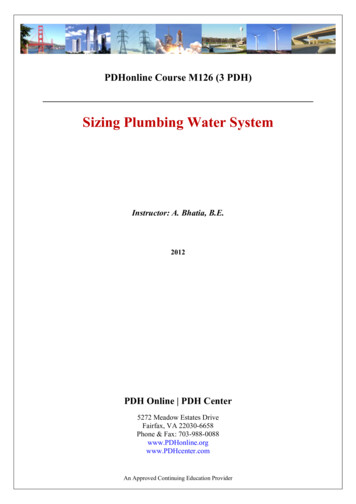
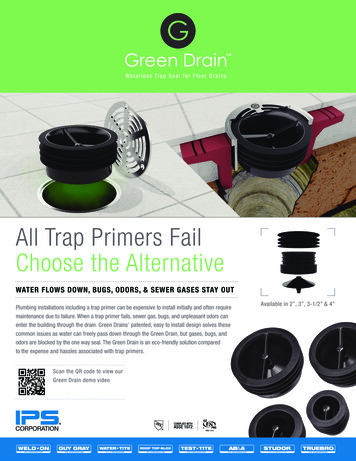
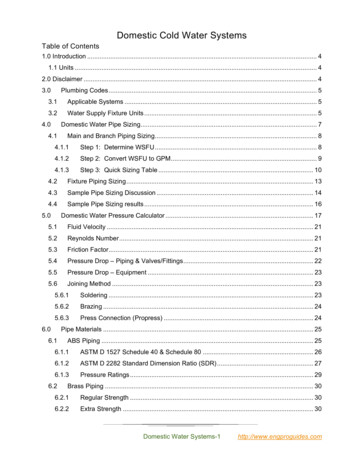
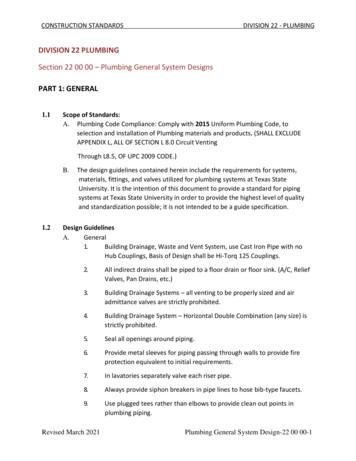
![Solar Code Development v2.5 [Read-Only]](/img/63/solar-20code-20development-20vfinal.jpg)
